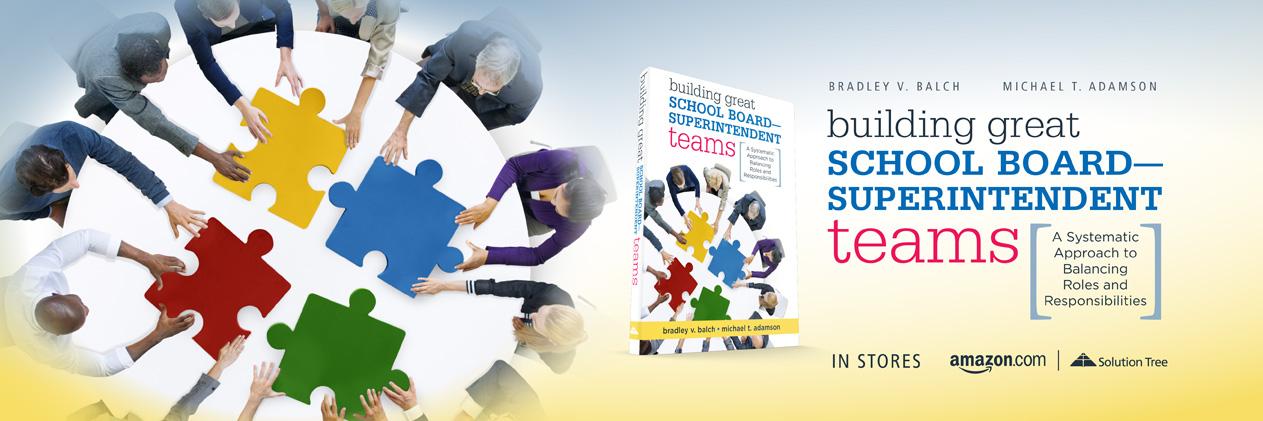This post is based on the book Building Great School Board–Superintendent Teams.
“Leadership theory runs swift and deep, the river banks crowded with animated commentators and interested observers. Governance theory trickles along the shallower backwaters; it attracts little notice and even fewer devotees” (Chait, Ryan, & Taylor, 2005, p. xix).
School boards and superintendents are a part of the educational culture throughout our nation. However, there is much debate regarding their role in education.
The History of School Boards and Superintendents
Public schools existed for about 200 years before the first superintendent appeared around 1870 in Louisville, Kentucky, and the job description has changed considerably. The position of superintendent that began primarily to develop and oversee curriculum, later evolved to include the duties and management of the business affairs of the district and, since 1945, has further evolved to a position of shared leadership (Townley, n.d.).
School boards, accordingly, date a couple hundred years further back than superintendents, with the first boards of record appearing a little after the Massachusetts Bay Colony’s mandate in 1647 that every town within its jurisdiction establish a public school. The committees that were formed to run those first public school institutions are the forerunners of school boards as we know them today (Frequently Asked Questions).
The preceding grants a brief glimpse regarding the origin of two of the most recognized positions in public schools today, but it does not share what or how those two positions, superintendents and school boards, function in the 21st century public school district.
Superintendents Today
Today, the job of a superintendent is still fundamentally the same as it has been for the past six decades; however, recognizing the similarities between superintendents at each end of that timeline or even in between may be more difficult. Some superintendents head districts with over 100,000 students, while others may have less than a hundred. Some are responsible for preK–12 students, and others may only have elementary, middle, junior high, or high school students. Some district central offices will have multitiered administrative and support staffs that are accountable for delegated responsibilities from the superintendent, while in small districts, the central office may only consist of the superintendent and one or two support staff members.
The mega-district versus small-district environment doesn’t dramatically change the overall responsibilities of the superintendent in either district, only how those responsibilities are accomplished. In a larger district, there is more delegation, with the superintendent more removed from direct management of subordinates at the building level, while in smaller districts, the superintendent is necessarily more hands-on.
School Boards Today
The same is true of school boards. Ideally, school boards function from a governance oversight perspective (Balch & Adamson, 2018). Most school board members are not educators; consequently, they deal with school issues primarily through policy, but that view is not completely sterile either. Most boards will meet once or twice per month to conduct business such as paying claims, allocating future expenditures and receiving information regarding district issues and performance, and so on. In between these regular meetings, boards receive other updates from the superintendent or his or her delegates, to keep them informed and to share essential information between regular meetings. So, although board members are not full-time school employees, they do brush against public education at regular intervals, to peer in and receive information directly or indirectly from the superintendent that confirms the district is operating as expected and as reported.
That simple description of board member service begs the question, what does being a board member mean? It means board members operate from a position of leadership; however, the expectation is not one of individual leadership but collective leadership, with all board members sharing equal responsibility. Board members either have the best or worst job in public education; they are accountable for everything, yet they manage nothing! Understanding the difference between management and leadership is crucial for every board if their goal is truly one that pursues effective governance.
A superintendent’s position, on the other hand, is pivotal, since he or she operates as both leader and manager, depending on the circumstance. While school boards should always act from a leadership platform, superintendents must both lead and manage, to the degree dictated by their position. How well a superintendent balances leadership and management impacts the district’s overall strategic health.
The Relationship Between School Boards and Superintendents
There must be an intentional desire by school board members and superintendents to not only forge, maintain, and protect a healthy relationship built on mutual respect, but also to create a professional, collegial environment where decisions that allow educational excellence to thrive are actively pursued. Plus, they must accomplish this while tediously balancing fiduciary, strategic, and generative leadership (Chait, Ryan, & Taylor, 2005) solutions that address the complex issues facing public education today.
Furthermore, the relationship must constantly be reinforced. Like any relationship, the one between boards and superintendents needs routine preventive maintenance. Even the best superintendents and school boards need performance reviews, exploratory sessions to ensure that their relationship does not succumb to one of apathy or that inertia does not replace their mutual drive for continuous improvement. Consequently, maintaining a great team is very similar to the childhood game of king of the hill. Getting to the top often takes a lot of effort and personal sacrifice, but it takes an equal amount of effort, or maybe even more, to stay on top. There are always outside influences that can threaten the relationship.
Often, meeting each other’s requirements is critical. For this reason, there needs to be an open dialogue that permits either side to communicate with the other if expectations are not being met, rather than waiting for annual performance reviews. For the superintendent, that can be tricky, considering that he or she is dealing with multiple board members with distinct personalities and expectations. This means the board must speak with a single voice to share what they collectively need the superintendent to provide. Alternatively, the superintendent must be willing to share when board action, or inaction, interferes with the management of the district.
The school board–superintendent relationship is one of the most vital and complex connections in public education. This forging between community and education, leadership and management, sets the tone for every school district’s performance, both academically and professionally. Taking the time to nurture and protect the school board–superintendent relationship allows precious resources to be focused where they are need most, on effective governance and excellence in education.
References:
Balch, B. V., & Adamson, M. T. (2018). Building Great School Board–Superintendent Teams. Bloomington, IN: Solution Tree.
Chait, R., Ryan, W., & Taylor, B. (2005). Governance as leadership. Hoboken, NJ: John Wiley & Sons.
Frequently Asked Questions. (n.d.). Retrieved October 27, 2017, from NSBA: https://www.nsba.org/ABOUT-US/FREQUENTLY-ASKED-QUESTIONS
Townley, A. J. (n.d.). “The School Superintendent.” Retrieved October 26, 2017 from http://www.stanswartz.com/adminbook/chap7.htm
[author_bio id=”1409″]








Dr. Adamson, beyond reinforcing the relationship through open communication of expectations between superintendent and school board, would you agree that a board must come together on a shared vision for the schools, given that today the majority of most boards will outlast the tenure of most superintendents? Boards may not have responsibility for managing the schools, but they do tend to have greater longevity than a lot of superintendents. This means that the board’s collective vision and common understanding of local challenges and stakeholder expectations is critical in selecting the superintendent, then collaboratively setting goals and objectives with him/her. I only make this distinction because this type of sustained clarity of vision should have a huge role to play in the board/superintendent relationship (which, by the way, I believe your book does address!) Paul Breda
Mr. Breda,
I heartedly concur with the formation and use of foundation statements to guide decision-making at every level of governance withing a school district. It is especially desirable, as you have stated, in the school board-superintendent team construct.
Because there is a high degree of board member turnover (in Indiana, it approaches a 46% turnover percentage rate [about 770 members among the 289 districts]every four years) these guiding statements help to provide continuity and stability in purpose during periods of change in the governing body. This is equally true for superintendents and other administrators who arrive in a district where the values, beliefs, mission, and vision have been established as standards against which decisions are measured for viability and priority.
It is certainly possible for board members to outlast superintendents; however, that possibility decreases with the size of districts. A two-term board member (8 years) is easily postured to ultimately serve longer than the national average for superintendents who serve in the same district. However, breaking that down farther, larger districts seem to have greater superintendent turnover overall, while superintendents in smaller districts enjoy greater stability, often significantly exceeding the national average.
-Michael Adamson